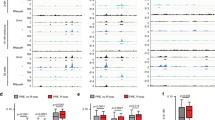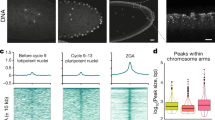Abstract
In Drosophila, the function of the Polycomb group genes (PcGs) and their target sequences (Polycomb response elements (PREs)) is to convey mitotic heritability of transcription programmes — in particular, gene silencing. As part of the mechanisms involved, PREs are thought to mediate this transcriptional memory function by building up higher-order structures in the nucleus. To address this question, we analysed in vivo the three-dimensional structure of the homeotic locus bithorax complex (BX-C) by combining chromosome conformation capture (3C) with fluorescent in situ hybridization (FISH) and FISH immunostaining (FISH-I) analysis. We found that, in the repressed state, all major elements that have been shown to bind PcG proteins, including PREs and core promoters, interact at a distance, giving rise to a topologically complex structure. We show that this structure is important for epigenetic silencing of the BX-C, as we find that major changes in higher-order structures must occur to stably maintain alternative transcription states, whereas histone modification and reduced levels of PcG proteins determine an epigenetic switch that is only partially heritable.
This is a preview of subscription content, access via your institution
Access options
Subscribe to this journal
Receive 12 print issues and online access
$209.00 per year
only $17.42 per issue
Buy this article
- Purchase on Springer Link
- Instant access to full article PDF
Prices may be subject to local taxes which are calculated during checkout





Similar content being viewed by others
References
Schuettengruber, B., Chourrout, D., Vervoort, M., Leblanc, B. & Cavalli, G. Genome regulation by polycomb and trithorax proteins. Cell 128, 735–745 (2007).
Orlando, V. Polycomb, epigenomes and control of cell identity. Cell 112, 591–606 (2003).
Levine, S. S., King, I. F. & Kingston, R. E. Division of labor in polycomb group repression. Trends Biochem. Sci. 29, 478–485 (2004).
Bantignies, F., Grimaud, C., Lavrov, S., Gabut, M. & Cavalli, G. Inheritance of Polycomb-dependent chromosomal interactions in Drosophila. Genes Dev. 17, 2406–2420 (2003).
Cleard, F., Moshkin, Y., Karch, F. & Maeda, R. K. Probing long-distance regulatory interactions in the Drosophila melanogaster bithorax complex using Dam identification. Nature Genet. 38, 931–935 (2006).
Comet, I. et al. PRE-mediated bypass of two Su(Hw) insulators targets PcG proteins to a downstream promoter. Dev. Cell 11, 117–124 (2006).
Pirrotta, V. PcG complexes and chromatin silencing. Curr. Opin. Genet. Dev. 7, 249–258 (1997).
Lanzuolo, C. & Orlando, V. The function of the epigenome in cell reprogramming. Cell. Mol. Life Sci. 64, 1043–1062 (2007).
Petruk, S. et al. Transcription of bxd noncoding RNAs promoted by trithorax represses Ubx in cis by transcriptional interference. Cell 127, 1209–1221 (2006).
Rank, G., Prestel, M. & Paro, R. Transcription through intergenic chromosomal memory elements of the Drosophila bithorax complex correlates with an epigenetic switch. Mol. Cell. Biol. 22, 8026–8034 (2002).
Schmitt, S., Prestel, M. & Paro, R. Intergenic transcription through a polycomb group response element counteracts silencing. Genes Dev. 19, 697–708 (2005).
Ronshaugen, M. & Levine, M. Visualization of trans-homolog enhancer-promoter interactions at the Abd-B Hox locus in the Drosophila embryo. Dev. Cell 7, 925–932 (2004).
Vazquez, J., Muller, M., Pirrotta, V. & Sedat, J. W. The Mcp element mediates stable long-range chromosome-chromosome interactions in Drosophila. Mol. Biol. Cell 17, 2158–2165 (2006).
Gasser, S. M. Visualizing chromatin dynamics in interphase nuclei. Science 296, 1412–1416 (2002).
Lanctot, C., Cheutin, T., Cremer, M., Cavalli, G. & Cremer, T. Dynamic genome architecture in the nuclear space: regulation of gene expression in three dimensions. Nature Rev. Genet. 8, 104–115 (2007).
Misteli, T. Beyond the sequence: cellular organization of genome function. Cell 128, 787–800 (2007).
Buchenau, P., Hodgson, J., Strutt, H. & Arndt-Jovin, D. J. The distribution of polycomb-group proteins during cell division and development in Drosophila embryos: impact on models for silencing. J. Cell Biol. 141, 469–481 (1998).
Ficz, G., Heintzmann, R. & Arndt-Jovin, D. J. Polycomb group protein complexes exchange rapidly in living Drosophila. Development 132, 3963–3976 (2005).
Breiling, A., O'Neill, L. P., D'Eliseo, D., Turner, B. M. & Orlando, V. Epigenome changes in active and inactive polycomb-group-controlled regions. EMBO Rep. 5, 976–982 (2004).
Breiling, A., Turner, B. M., Bianchi, M. E. & Orlando, V. General transcription factors bind promoters repressed by Polycomb group proteins. Nature 412, 651–655 (2001).
Beuchle, D., Struhl, G. & Muller, J. Polycomb group proteins and heritable silencing of Drosophila Hox genes. Development 128, 993–1004 (2001).
Fukagawa, T. et al. Dicer is essential for formation of the heterochromatin structure in vertebrate cells. Nature Cell Biol. 6, 784–791 (2004).
Kanellopoulou, C. et al. Dicer-deficient mouse embryonic stem cells are defective in differentiation and centromeric silencing. Genes Dev. 19, 489–501 (2005).
Lippman, Z. & Martienssen, R. The role of RNA interference in heterochromatic silencing. Nature 431, 364–370 (2004).
Maison, C. et al. Higher-order structure in pericentric heterochromatin involves a distinct pattern of histone modification and an RNA component. Nature Genet. 30, 329–334 (2002).
Volpe, T. A. et al. Regulation of heterochromatic silencing and histone H3 lysine-9 methylation by RNAi. Science 297, 1833–1837 (2002).
Grimaud, C. et al. RNAi components are required for nuclear clustering of Polycomb group response elements. Cell 124, 957–971 (2006).
Lei, E. P. & Corces, V. G. RNA interference machinery influences the nuclear organization of a chromatin insulator. Nature Genet. 38, 936–941 (2006).
de Laat, W. & Grosveld, F. Spatial organization of gene expression: the active chromatin hub. Chromosome Res. 11, 447–459 (2003).
Kumar, P. P. et al. Functional interaction between PML and SATB1 regulates chromatin-loop architecture and transcription of the MHC class I locus. Nature Cell Biol. 9, 45–56 (2007).
Kurukuti, S. et al. CTCF binding at the H19 imprinting control region mediates maternally inherited higher-order chromatin conformation to restrict enhancer access to Igf2. Proc. Natl Acad. Sci. USA 103, 10684–10689 (2006).
Chambeyron, S. & Bickmore, W. A. Chromatin decondensation and nuclear reorganization of the HoxB locus upon induction of transcription. Genes Dev. 18, 1119–1130 (2004).
Chambeyron, S., Da Silva, N. R., Lawson, K. A. & Bickmore, W. A. Nuclear re-organisation of the Hoxb complex during mouse embryonic development. Development 132, 2215–2223 (2005).
Lemaitre et al., Mitotic remodeling of the replicon and chromosome structure. Cell 123, 787–801 (2005)
Dekker, J., Rippe, K., Dekker, M. & Kleckner, N. Capturing chromosome conformation. Science 295, 1306–1311 (2002).
Orlando, V., Jane, E. P., Chinwalla, V., Harte, P. J. & Paro, R. Binding of trithorax and Polycomb proteins to the bithorax complex: dynamic changes during early Drosophila embryogenesis. EMBO J. 17, 5141–5150 (1998).
Acknowledgements
We thank G. Cavalli for providing lab space and funding to perform the work done by F.B. and V.R., stimulating discussions and constructive criticisms about this manuscript. We thank A. Breiling, G. Oliva, N. Hornig, M. Vivo, Z. Jasencakova, M. Matarazzo and F. Cernilogar for helpful comments on the manuscript and technical advice. We are grateful to A. Ambesi-Impiombato, D. Di Bernardo, A. Buonocore, E. Pirozzi and A. Mas for statistical analysis, and to D. Romano for modelling the 3D image. This work was supported by grants from Fondazione Telethon (TCP00094), La Compagnia di San Paolo, Associazione Italiana Ricerca sul Cancro AIRC, VolkwagenStiftung (I77 996) and The Epigenome Network of Excellence (LSHG-CT-2004-503433) to V.O.; by the National Institutes of Health (HG03143) to J.D. V.R. is supported by the Ministère de la Recherche, F.B. is supported by the CNRS. C.L. and V.O. would like to dedicate this work to the heart and soul of Maria Graziella Persico.
Author information
Authors and Affiliations
Contributions
C.L. performed all 3C experiments, FISH analysis on Drosophila S2 and S3 cells and part of statistical analysis. V.R. and F.B. performed FISH experiments on embryos and helped C.L. with FISH analysis in S2 and S3 cells. J.D. provided unpublished protocols on 3C technology and suggested crucial control experiments. V.O. designed the experiments, participated in data analysis and presentation, and prepared the manuscript together with C.L. At all stages, all authors discussed the results and gave a substantial contribution to the final manuscript.
Corresponding author
Supplementary information
Supplementary Information.
Supplementary Figures S1, S2, S3, S4 and S5 (PDF 508 kb)
Rights and permissions
About this article
Cite this article
Lanzuolo, C., Roure, V., Dekker, J. et al. Polycomb response elements mediate the formation of chromosome higher-order structures in the bithorax complex. Nat Cell Biol 9, 1167–1174 (2007). https://doi.org/10.1038/ncb1637
Received:
Accepted:
Published:
Issue Date:
DOI: https://doi.org/10.1038/ncb1637
This article is cited by
-
Mechanisms of Polycomb group protein function in cancer
Cell Research (2022)
-
Phytochrome B triggers light-dependent chromatin remodelling through the PRC2-associated PHD finger protein VIL1
Nature Plants (2021)
-
Tracing DNA paths and RNA profiles in cultured cells and tissues with ORCA
Nature Protocols (2021)
-
Profound alterations of the chromatin architecture at chromosome 11p15.5 in cells from Beckwith-Wiedemann and Silver-Russell syndromes patients
Scientific Reports (2020)
-
Multiplex chromatin interactions with single-molecule precision
Nature (2019)



